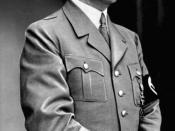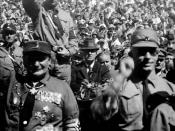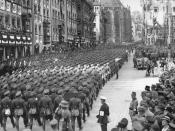ÃÂLeni RiefenstahlÃÂs ÃÂTriumph of the WillÃÂ is a significant piece of work from the perspective of the whole National Socialist cinema. Not only is it the most famous of the films made during the period of the Third Reich, but it is also the only Nazi film made directly about Hitler. Hitler had commissioned the film to portray him the way he wanted to be seen: as the embodiment of Germany and its people. That identification was meant to be mutual: just as Hitler was the reflection of them, the German people were the same of Hitler. Rudolf HessÃÂ words at the end of the film fit to illustrate that relationship the best: ÃÂThe Party is Hitler. But Hitler is Germany, just as Germany is HitlerÃÂ. ÃÂTriumph of the WillÃÂ served to identify Hitler with Germany and vice versa, he was depicted as the representation of everything German and the sole personification of the ÃÂNew GermanyÃÂ that was proclaimed to last for thousand years.
Hitler ordered the film to put an equal sign between him and his people and country and Leni Riefenstahl used numerous devices to stress that idea of identification.
The mythical image of Hitler as the carrier of ideals is displayed already in the first scenes of the film. We see him descending from the skies on an aeroplane and his followers anxiously waiting for his arrival. Through the clouds Nuremberg, ÃÂthe most German of the German citiesÃÂ, can be seen with its medieval towers and spires and the streets and lined by thousands of marching soldiers, creating the first geometric pattern of humanity to be shown in the film. The reference to messiah is definitely not an incidental one. Throughout the film, Hitler is juxtaposed against the sky as to remind his divine origin.


